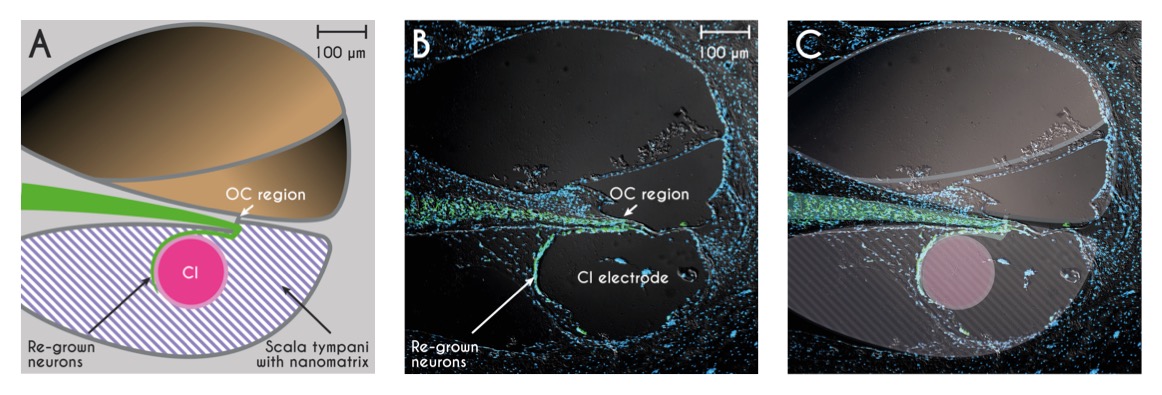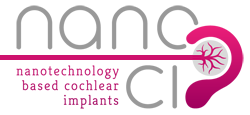NANOCI project successfully completed
The NANOCI project has been successfully completed, and the publication of final results in peer-reviewed journals is underway. The main results are already available on the Output section of the NANOCI website:
Combining all developments of the NANOCI project, the proof of concept for the gap-less interface between auditory neurons and the cochlear implant electrodes has been obtained in vivo (see figure). The in vitro setup confirmed the hypothesis that a significant reduction in energy used to stimulate the auditory neurons can be achieved, notably a five-fold reduction for the gapless position and a four-fold reduction, if stimulus parameters are optimized for the new interface. Together, these key findings lay the foundation to develop cochlear implant systems in the future with more specific and more energy-efficient stimulation of auditory neurons.

Guided growth of auditory neuronal fibers (green) from the organ of Corti (OC) region towards the drug-releasing nanomatrix (blue-shaded area) and cochlear implant electrode array (CI, pink) to form a gapless neuron:electrode interface in concept (A), in vivo (B) and merged (A+B = C). The electrode materials (silicone and platinum) are difficult to section and visualize, however the space occupied by the CI electrode is well delineated (B). The CI electrode implanted was larger compared to the original concept (difference of CI electrode area in C).
New NANOCI publications
The NANOCI project is now on the home straight and the validation of the final device is well under way. The animal-grade cochlear implant includes all the individual components developed in the course of the project. For example, new electrodes with superior electrical characteristics have been designed, novel neurotrophins can be released in a gel like matrix to stimulate regrowth of nerve fibres and antimicrobial nanoparticles were added.
Results of the validation are keenly awaited by the team and should be available in Autumn 2015 on this website. Over the course of the last months eight peer-reviewed articles which were published in 2015 and focus on individual aspects of NANOCI were added to the NANOCI publication list:- Auditory Nerve Preservation and Regeneration in Man - Relevance for Cochlear Implantation. Helge Rask-Andersen and Wei Li. Neural Regeneration Research, 10(5), 710-712–65, 2015. doi:10.4103/1673-5374.156963
- X-ray microtomographic confirmation of the reliability of CBCT in identifying the scalar location of cochlear implant electrode after round window insertion. Zou J, Hannula M, Lehto K, Feng H, Lähelmä J, Aula AS, Hyttinen J, Pyykkö I. Hearing Research, 326, 59–65, 2015. doi:10.1016/j.heares.2015.04.005
- Solid on liquid deposition, a review of technological solutions. Alexandra Homsy, Edith Laux, Laure Jeandupeux, Jerome Charmet, Roland Bitterli, Chiara Botta, Yves Rebetez, Oksana Banakh, H. Keppner. Microelectronic Engineering, 141, 267–79, 2015. doi:10.1016/j.mee.2015.03.068
- Imaging cochlear implantation with round window insertion in human temporal bones and cochlear morphological variation using high-resolution cone beam CT. Zou J, Lähelmä J, Koivisto J, Dhanasingh A, Jolly C, Aarnisalo A, Wolff J, Pyykkö I. Acta Otolaryngol. 135(5), 466-472, 2015. doi:10.3109/00016489.2014.993090
- Macromolecular organization and fine structure of the human basilar membrane - RELEVANCE for cochlear implantation. Wei Liu, Francesca Atturo, Robair Aldaya, Peter Santi, Sebahattin Cureoglu, Sabrina Obwegeser, Rudolf Glueckert, Kristian Pfaller, Annelies Schrott-Fischer and Helge Rask-Andersen. Cell Tissue Res. 360(2), 245–262, 2015. doi:10.1007/s00441-014-2098-z
- Imaging Optimization of Temporal Bones With Cochlear Implant Using a High-resolution Cone Beam CT and the Corresponding Effective Dose. Jing Zou, Juha Koivisto, Jaakko Lähelmä, Antti Aarnisalo, Jan Wolff, and Ilmari Pyykkö. Ann Otol Rhinol Laryngol 124(6) 466-473, 2015. doi:10.1177/0003489414565004
- MeV ion beam lithography of biocompatible halogenated Parylenes using aperture masks. Harry J. Whitlow, Rattanaporn Norarat, Marta Roccio, Patrick Jeanneret, Edouard Guibert, Maxime Bergamin, Gianni Fiorucci, Alexandra Homsy, Edith Laux, Herbert Keppner, Pascal Senn. Nuclear Instruments and Methods in Physics Research, Section B: Beam Interactions with Materials and Atoms. 354, 34–36, 2015. doi:10.1016/j.nimb.2014.10.024
- The pre- and post-somatic segments of the human type I spiral ganglion neurons – Structural and functional considerations related to cochlear implantation. W. Liu , F. Edin , F. Atturo , G. Rieger , H. Löwenheim , P. Senn , M. Blumer , A. Schrott-Fischer , H. Rask-Andersen , R. Glueckert. Neuroscience, 284, 470-482, 2015. doi:10.1016/j.neuroscience.2014.09.059
NANOCI results overview
See also the list of publications issued by the project. More publications are in preparation.
Interview on the NANOCI project
Source: «unilink December 2013 issue.
Day of Clinical Research 2013: And the winners are ...
Johanna Dürmüller-Bol DCR Research Prize 2013, CHF 30‘000.-
The prestigious Research Prize goes this year to Dr. Marta Roccio, Department of Ear, Nose and Throat Diseases, Head and Neck Surgery, Inselspital, Bern University Hospital; Audiology Research Group, Department of Clinical Research, University of Bern, for her research project on
"Reactivation of dormant inner ear stem cells through modulation of cell cycle and developmental regulators"
DCR Poster Prizes
The prize for the best laboratory-oriented project out of 170 contestants goes this year to Mr. Stefan Hahnewald, Department of Ear, Nose and Throat Diseases, Head and Neck Surgery, Inselspital, Bern University Hospital; Audiology Research Group, Department of Clinical Research, University of Bern, for his work on
"First steps towards a gapless interface between auditory neurons and multi-electrode arrays in vitro"
Source: http://www.dkf.unibe.ch/index.php?id=305&lang=de&lang=en
